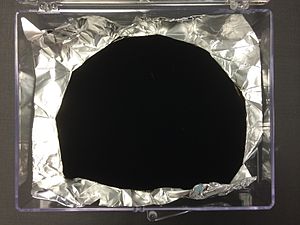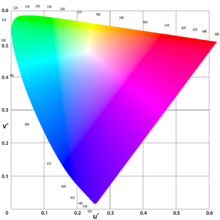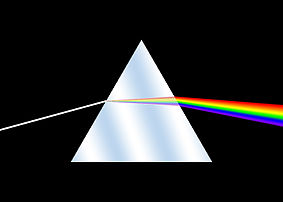想要理解什麼是『灰色』其實並不容易!?
Grey
Grey (British English) or gray (American English;[citation needed] see spelling differences) is an intermediate color between black and white. It is a neutral or achromatic color, meaning literally that it is a color “without color.”[2] This means that there are equal components of red, green, and blue. The variations in intensity of these colors uniformly produce different shades of grey. It is the color of a cloud-covered sky, of ash and of lead.[3]
The first recorded use of grey as a color name in the English language was in AD 700.[4] Grey is the dominant spelling in European and Commonwealth English, although gray remained in common usage in the UK until the second half of the 20th century.[5] Gray has been the preferred American spelling since approximately 1825,[6] although grey is an accepted variant.[7][8]
In Europe and the United States, surveys show that grey is the color most commonly associated with neutrality, conformity, boredom, uncertainty, old age, indifference, and modesty. Only one percent of respondents chose it as their favorite color.[9]

因為『純灰』指稱沒有『色相』 HUE 之『顏色』也◎
色相
色相指的是色彩的外相,是在不同波長的光照射下,人眼所感覺不同的顏色,如紅色、黃色、藍色等。
在HSL和HSV色彩空間中,H指的就是色相,是以紅色為0度(360度);黃色為60度;綠色為120度;青色為180度;藍色為240度;品紅色為300度。
| 顏色名稱 | 紅綠藍含量 | 角度 | 代表物體 |
|---|---|---|---|
| 紅色 | R255,G0,B0 | 0° | 血液、草莓 |
| 橙色 | R255,G128,B0 | 30° | 火、橙子 |
| 黃色 | R255,G255,B0 | 60° | 香蕉、杧果 |
| 黃綠 | R128,G255,B0 | 90° | 檸檬 |
| 綠色 | R0,G255,B0 | 120° | 草、樹葉 |
| 青綠 | R0,G255,B128 | 150° | 軍裝 |
| 青色 | R0,G255,B255 | 180° | 水面、天空 |
| 靛藍 | R0,G128,B255 | 210° | 水面、天空 |
| 藍色 | R0,G0,B255 | 240° | 樹根、墨水 |
| 紫色 | R128,G0,B255 | 270° | 葡萄、茄子 |
| 品紅 | R255,G0,B255 | 300° | 火、桃子 |
| 紫紅 | R255,G0,B128 | 330° | 墨水 |

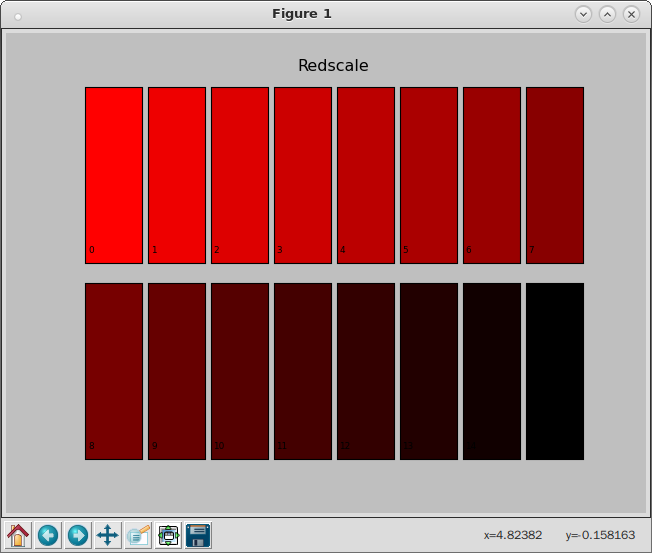
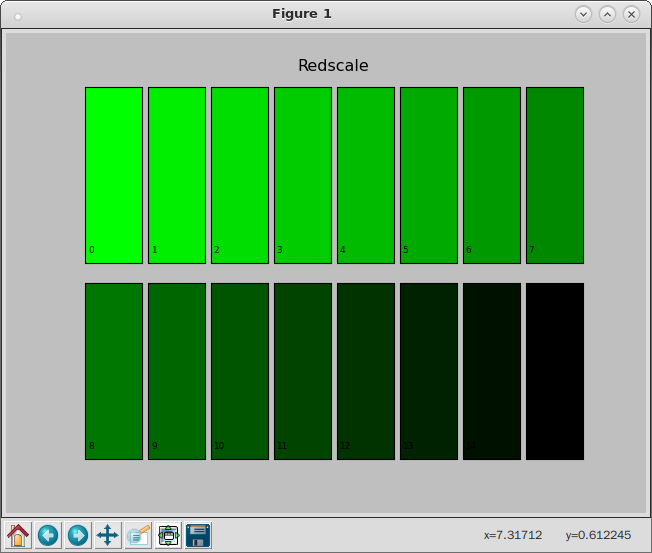
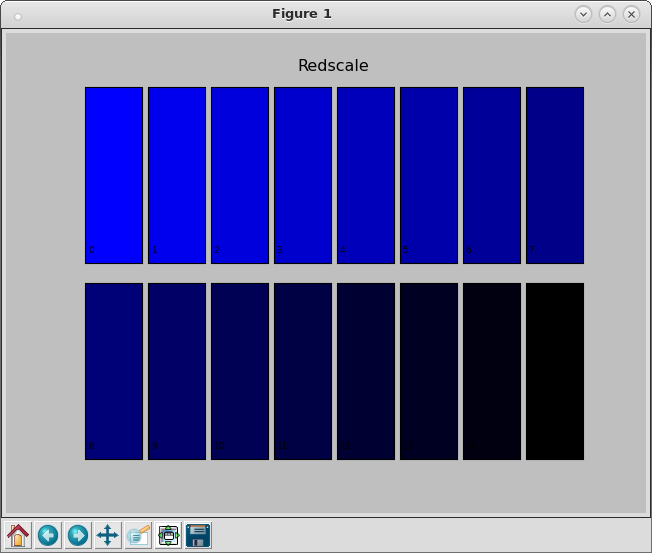
彷彿人眼所見『彩色世界』的『三原色』之『均等色』哩!!莫要以為只有『無光』才是『黑』??人人之不同或未必有『相同』之『知覺』,如何求其『齊頭一致』耶!!
Black
Black is the darkest color, resulting from the absence or complete absorption of light. Like white and grey, it is an achromatic color, literally a color without hue.[1] It is one of the four primary colors in the CMYK color model, along with cyan, yellow, and magenta, used in color printing to produce all the other colors. Black is often used to represent darkness; it is the symbolic opposite of white (or brightness).
Black was one of the first colors used by artists in neolithic cave paintings. In the 14th century, it began to be worn by royalty, the clergy, judges and government officials in much of Europe. It became the color worn by English romantic poets, businessmen and statesmen in the 19th century, and a high fashion color in the 20th century.[2]
In the Roman Empire, it became the color of mourning, and over the centuries it was frequently associated with death, evil, witches and magic. According to surveys in Europe and North America, it is the color most commonly associated with mourning, the end, secrets, magic, force, violence, evil, and elegance.[3]
Science
Physics
In the visible spectrum, black is the absorption of all colors.
Black can be defined as the visual impression experienced when no visible light reaches the eye. Pigments or dyes that absorb light rather than reflect it back to the eye “look black”. A black pigment can, however, result from a combination of several pigments that collectively absorb all colors. If appropriate proportions of three primary pigments are mixed, the result reflects so little light as to be called “black”.
This provides two superficially opposite but actually complementary descriptions of black. Black is the absorption of all colors of light, or an exhaustive combination of multiple colors of pigment. See also primary colors.
In physics, a black body is a perfect absorber of light, but, by a thermodynamic rule, it is also the best emitter. Thus, the best radiative cooling, out of sunlight, is by using black paint, though it is important that it be black (a nearly perfect absorber) in the infrared as well.
In elementary science, far ultraviolet light is called “black light” because, while itself unseen, it causes many minerals and other substances to fluoresce.
On January 16, 2008, researchers from Troy, New York‘s Rensselaer Polytechnic Institute announced the creation of the then darkest material on the planet. The material, which reflected only 0.045 percent of light, was created from carbon nanotubes stood on end. This is 1/30 of the light reflected by the current standard for blackness, and one third the light reflected by the previous record holder for darkest substance.[30] As of February 2016, the current darkest material known is claimed to be Vantablack.[31][32]
A material is said to be black if most incoming light is absorbed equally in the material. Light (electromagnetic radiation in the visible spectrum) interacts with the atoms and molecules, which causes the energy of the light to be converted into other forms of energy, usually heat. This means that black surfaces can act as thermal collectors, absorbing light and generating heat (see Solar thermal collector).
Absorption of light is contrasted by transmission, reflection and diffusion, where the light is only redirected, causing objects to appear transparent, reflective or white respectively.
-
Vantablack is made of carbon nanotubes[33] and is the blackest substance known, absorbing a maximum of 99.965% of radiation in the visible spectrum.[34]
故,所謂『光譜』生『色彩知覺』
Spectral color
A spectral color is a color that is evoked by a single wavelength of light in the visible spectrum, or by a relatively narrow band of wavelengths, also known as monochromatic light. Every wavelength of visible light is perceived as a spectral color, in a continuous spectrum; the colors of sufficiently close wavelengths are indistinguishable.
The spectrum is often divided into named colors, though any division is somewhat arbitrary: the spectrum is continuous. Traditional colors include: red, orange, yellow, green, blue, and violet.
The division used by Isaac Newton, in his color wheel, was: red, orange, yellow, green, blue, indigo and violet; a mnemonic for this order is “Roy G. Biv“. In modern divisions of the spectrum, indigo is often omitted.
One needs at least trichromatic color vision for there to be a distinction between spectral and non-spectral colours[dubious ]: trichromacy gives a possibility to perceive both hue and saturation in the chroma. In color models capable of representing spectral colors,[1] such as CIELUV, a spectral color has the maximal saturation.
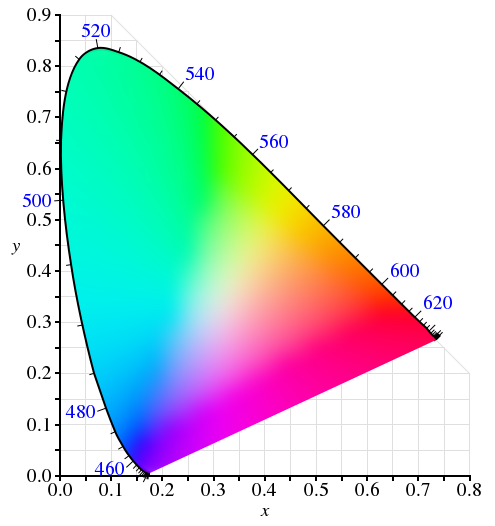
The CIE xy chromaticity diagram. The spectrum colors are the colors on the horseshoe-shaped curve on the outside of the diagram. All other colors are not spectral: the bottom straight line is the line of purples, whilst within the interior of the diagram are unsaturated colors that are various mixtures of a spectral color or a purple color with white, a grayscale color. White is in the central part of the interior of the diagram, since when all colors of light are mixed together, they produce white.
In color spaces
In color spaces which include all, or most spectral colors, they form a part of boundary of the set of all real colors. If luminance is counted, then spectral colors form a surface, otherwise their locus is a curve in a two-dimensional chromaticity space.
Theoretically, only RGB-implemented colors which might be really spectral are its primaries: red, green, and blue, whereas any other (mixed) color is inherently non-spectral. But due to different chromaticity properties of different spectral segments, and also due to practical limitations of light sources, the actual distance between RGB pure color wheel colors and spectral colors shows a complicated dependence on the hue. Due to location of R and G primaries near the almost “flat” spectral segment, RGB color space is reasonably good with approximating spectral orange, yellow, and bright (yellowish) green, but is especially poor in reaching a visual appearance of spectral colors between green and blue, as well as extreme spectral colors. The sRGB standard has an additional problem with its “red” primary which is shifted to orange due to a trade-off between purity of red and its reasonable luminance, so that the red spectral became unreachable. Some samples in the table below provide only rough approximations of spectral and near-spectral colors.
CMYK is usually even poorer than RGB in its reach of spectral colors, with notable exception of process yellow, which is rather close to spectral colors due to aforementioned flatness of the spectral locus in the red–green segment.
Note that spectral color are universally included to scientific color models such as CIE 1931, but industrial and consumer color spaces such as sRGB, CMYK, and Pantone, do not include any of spectral colors.
,暫不論『光譜色』鮮矣哉,『日光白』豈不是共通之『參考點』乎??
白色
白色是一種包含光譜中所有顏色光的顏色,通常被認為是「無色」的,(但和黑色的無色正相反),其明度最高,色相為零。可以將光譜中三原色的光:紅色、藍色和綠色按一定比例混合得到白光。光譜中所有可見光的混合也是白光。
白光
以前許多科學家認為,白光是最基本的光,其他顏色的光是在白光上添加了某些元素。但英國科學家艾薩克·牛頓的研究,揭露了白光是由光譜中各種顏色的光組成的。現在光學中,稱黑體在加熱到不同溫度釋放出的輻射光都叫做「白光」,最低發光溫度為2848 K,相當於白熾燈泡的溫度;劇場中白光等溫度達到3200K;白天天光的溫度相當於5400K,但是由多種顏色的光組成的,從最低溫度的紅光到將近25000K的紫光都包括在內。但並不是所有黑體輻射都是白光,宇宙背景輻射也是黑體輻射,只有3K。
標準白光
國際照明協會所規定的標準白光是6500K時的黑體輻射,相當於白天的天光。
White
White is an achromatic color, a color without hue.[1]
Light with a spectral composition that stimulates all three types of the color sensitive cone cells of the human eye in nearly equal amounts appears white. White is one of the most common colors in nature, the color of sunlight, and the color of sunlight reflected by snow, milk, chalk, limestone and other common minerals. In many cultures white represents or signifies purity, innocence, and light, and is the symbolic opposite of black, or darkness. According to surveys in Europe and the United States, white is the color most often associated with perfection, the good, honesty, cleanliness, the beginning, the new, neutrality, and exactitude.[2]
In ancient Egypt and ancient Rome, priestesses wore white as a symbol of purity, and Romans wore a white toga as a symbol of citizenship. In the Middle Ages and Renaissance a white unicorn symbolized chastity, and a white lamb sacrifice and purity; the widows of kings dressed in white rather than black as the color of mourning. It sometimes symbolizes royalty; it was the color of the French kings (black being the color of the queens) and of the monarchist movement after the French Revolution as well as of the movement called the White Russians (not to be confounded with Belarus, literally “White Russia”) who fought the Bolsheviks during the Russian Civil War (1917–1922). Greek and Roman temples were faced with white marble, and beginning in the 18th century, with the advent of neoclassical architecture, white became the most common color of new churches, capitols and other government buildings, especially in the United States. It was also widely used in 20th century modern architecture as a symbol of modernity, simplicity and strength.
White is an important color for almost all world religions. The Pope, the head of the Roman Catholic Church, has worn white since 1566, as a symbol of purity and sacrifice. In Islam, and in the Shinto religion of Japan, it is worn by pilgrims; and by the Brahmins in India. In Western cultures and in Japan, white is the most common color for wedding dresses, symbolizing purity and virginity. In many Asian cultures, white is also the color of mourning.[3]
The white color on television screens and computer monitors is created with the RGB color model by mixing red, green and blue light at equal intensities.[citation needed]
Science
Physics
White is the color the human visual system senses when the incoming light to the eye stimulates all three types of color sensitive cone cells in the eye in nearly equal amounts.[24] Materials that do not emit light themselves appear white if their surfaces reflect back most of the light that strikes them in a diffuse way.
In 1666, Isaac Newton demonstrated that white light could be broken up into its composite colors by passing it through a prism, then using a second prism to reassemble them. Before Newton, most scientists believed that white was the fundamental color of light.
White light can be generated by the sun, by stars, or by earthbound sources such as fluorescent lamps, white LEDs and incandescent bulbs. On the screen of a color television or computer, white is produced by mixing the primary colors of light: red, green and blue (RGB) at full intensity, a process called additive mixing (see image below). White light can be fabricated using light with only two wavelengths, for instance by mixing light from a red and cyan laser or yellow and blue lasers. This light will however have very few practical applications since color rendering of objects will be greatly distorted.
The fact that light sources with vastly different spectral power distributions can result in a similar sensory experience is due to the way the light is processed by the visual system. One color that arise from two different spectral power distributions is called a metamerism.
The International Commission on Illumination defines white (adapted) as “a color stimulus that an observer who is adapted to the viewing environment would judge to be perfectly achromatic and to have a luminance factor of unity. The color stimulus that is considered to be the adapted white may be different at different locations within a scene.[25]
The adaptation mentioned in the CIE definition above is the chromatic adaptation by which the same colored object in a scene experienced under very different illuminations will be perceived as having nearly the same color. The same principle is used in photography and cinematography where the choice of white point determines a transformation of all other color stimuli. Changes in or manipulation of the white point can be used to explain some optical illusions such as The dress.
-
In the RGB color model, used to create colors on TV and computer screens, white is made by mixing red, blue and green light at full intensity.
-
White light refracted in a prism revealing the color components.
Many of the light sources that emit white light emit light at almost all visible wavelengths (sun light, incandescent lamps of various Color temperatures). This has led to the notion that white light can be defined as a mixture of “all colors” or “all visible wavelengths”. This misconception is widespread[26][27] and might originally stem from the fact that Newton discovered that sunlight is composed of light with wavelengths across the visible spectrum. Concluding that since “all colors” produce white light then white must be made up of “all colors” is a common logical error called affirming the consequent, which might be the cause of the misunderstanding.
Why snow, clouds and beaches are white
Snow is a mixture of air and tiny ice crystals. When white sunlight enters snow, very little of the spectrum is absorbed; almost all of the light is reflected or scattered by the air and water molecules, so the snow appears to be the color of sunlight, white. Sometimes the light bounces around inside the ice crystals before being scattered, making the snow seem to sparkle.[28]
In the case of glaciers, the ice is more tightly pressed together and contains little air. As sunlight enters the ice, more light of the red spectrum is absorbed, so the light scattered will be bluish.[29]
Clouds are white for the same reason as ice. They are composed of water droplets or ice crystals mixed with air, very little light that strikes them is absorbed, and most of the light is scattered, appearing to the eye as white. Shadows of other clouds above can make clouds look gray, and some clouds have their own shadow on the bottom of the cloud.[30]
Many mountains with winter or year-round snow cover are named accordingly: Mauna Kea means white mountain in Hawaiian, Mont Blanc means white mountain in French. Changbai Mountains literally meaning perpetually white mountains, marks the border between China and Korea.
Beaches with sand containing high amounts of quartz or eroded limestone also appear white, since quartz and limestone reflect or scatter sunlight, rather than absorbing it. Tropical white sand beaches may also have a high quantity of white calcium carbonate from tiny bits of seashells ground to fine sand by the action of the waves.[31]
-
Mont Blanc in the Alps. It takes its name from the white snow on its summit.
-
Cumulus clouds look white because the water droplets reflect and scatter the sunlight without absorbing other colors.
-
Pensacola Beach, Florida. White sand beaches look white because the quartz or eroded limestone in the sand reflects or scatters sunlight without absorbing other colors.
所以『色彩空間』須『定義』
白點
白點(white point),在技術文檔中常被稱作參考白色(reference white)或目標白色(target white),是一組三色視覺值(tristimulus values)或色度值(Chromaticity)。它被用來在圖像捕獲、編碼和再現時定義白色。[1]白點的數值不是恆定的,需要按照使用場合的不同對它的數值做出相應的更改。例如在室內攝影時常用白熾燈來照明,而白熾燈的光線色溫相對日光較低,因而呈現出偏橙的顏色。倘若在這種情況下依然使用以日光為準的白點數值來定義白色,攝影的結果就會出現偏色的問題。
White point
A white point (often referred to as reference white or target white in technical documents) is a set of tristimulus values or chromaticity coordinates that serve to define the color “white” in image capture, encoding, or reproduction.[1] Depending on the application, different definitions of white are needed to give acceptable results. For example, photographs taken indoors may be lit by incandescent lights, which are relatively orange compared to daylight. Defining “white” as daylight will give unacceptable results when attempting to color-correct a photograph taken with incandescent lighting.
Illuminants
An illuminant is characterized by its relative spectral power distribution. The white point of an illuminant is the chromaticity of a white object under the illuminant, and can be specified by chromaticity coordinates, such as the x, y coordinates on the CIE 1931 chromaticity diagram (hence the use of the relative SPD and not the absolute SPD, because the white point is only related to color and unaffected by intensity).[2]
Illuminant and white point are separate concepts. For a given illuminant, its white point is uniquely defined. A given white point, on the other hand, generally does not uniquely correspond to only one illuminant. From the commonly used CIE 1931 chromaticity diagram, it can be seen that almost all non-spectral colors (all except those on the line of purples), including colors described as white, can be produced by infinitely many combinations of spectral colors, and therefore by infinitely many different illuminant spectra.
Although there is generally no one-to-one correspondence between illuminants and white points, in the case of the CIE D-series standard illuminants, the spectral power distributions are mathematically derivable from the chromaticity coordinates of the corresponding white points.[3]
Knowing the illuminant’s spectral power distribution, the reflectance spectrum of the specified white object (often taken as unity), and the numerical definition of the observer allows the coordinates of the white point in any color space to be defined. For example, one of the simplest illuminants is the “E” or “Equal Energy” spectrum. Its spectral power distribution is flat, giving the same power per unit wavelength at any wavelength. In terms of both the 1931 and 1964 CIE XYZ color spaces, its color coordinates are [k, k, k], where k is a constant, and its chromaticity coordinates are [x, y] = [1/3, 1/3].
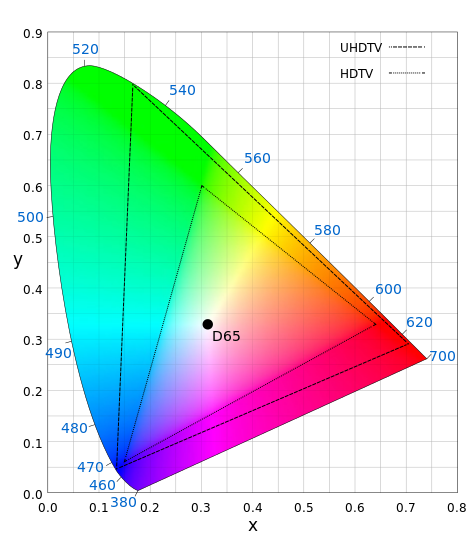
Diagram of the CIE 1931 color space that shows the Rec. 2020 (UHDTV) color space in the outer triangle and Rec. 709 (HDTV) color space in the inner triangle. Both Rec. 2020 and Rec. 709 use Illuminant D65 for the white point.
方可確定吧☆
